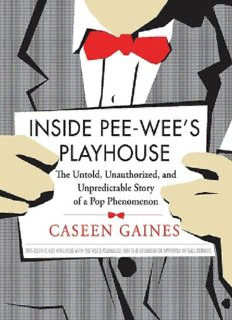
Inside Pee-Wee's Playhouse: The Untold, Unauthorized, and Unpredictable Story of a Pop Phenomenon PDF
Preview Inside Pee-Wee's Playhouse: The Untold, Unauthorized, and Unpredictable Story of a Pop Phenomenon
For my brother, Curtis, As proof you can do anything you put your mind to and a reminder not to rush to put aside childish things INTRODUCTION “Quality television programming can open wide the windows of curiosity for children and enable them to share in the wonder of man’s experience.” — Ronald Reagan, October 13, 1986 [© Ken Sax] In the spring of 1986, Saturday morning children’s television was popular, profitable, and predictable. The three major television networks, ABC, CBS, and NBC, aired cartoons that lacked in originality and, for the most part, had no educational value. There were superheroes (Spider-Man and His Amazing Friends, The Super Powers Team: Galactic Guardians), animated adaptations of live-action movies and TV shows (It’s Punky Brewster, Star Wars), new shows with established characters (Alvin and the Chipmunks, The Smurfs), and even a show starring a larger-than-life wrestling personality (Hulk Hogan’s Rock ‘n’ Wrestling). [© John Duke Kisch / CBS] As children urged their parents to empty their wallets for toys based on their favorite Saturday morning cartoons, some parents began paying closer attention to children’s programming, and many didn’t like what they saw. Critics described the networks’ lineups as being filled with “program-length commercials” for merchandising like Pound Puppies, G.I. Joe, and Care Bears. Peggy Charren, the founder and president of Action for Children’s Television, claimed that Saturday morning TV was “filled with do-goody nonsense” and she urged networks to introduce shows with more educational value. With the scrutiny of children’s television increasing, President Ronald Reagan established National Children’s Television Awareness Week that October, a month after the new season of Saturday morning programming debuted. Television as we knew it would be forever changed. Into the Saturday morning television war zone stepped Pee-wee Herman, the man-child in a too-small gray suit of armor, a soldier of a new era of creative children’s programming. While Pee-wee’s Playhouse was hardly the first show to blend animation, puppetry, and live-action — PBS’s Sesame Street had crossed that bridge almost 20 years earlier — it added a subversive, hipster sensibility to the format, providing a gust of fresh air to a tired timeslot reserved for the stale ideas of network execs. [© Ken Sax] Playhouse’s impact was immediate. The Washington Post described the program as “utterly magical, beautifully realized, and veritably giddy with plaintive charm.” The show gained the respect of parent advocacy groups and critics alike for being the lone Saturday morning children’s show that was not completely animated. In the weeks following its debut, Playhouse was frequently cited as being not only the best new show of the season, but the best program on Saturday morning, period. As William S. Burroughs once said, “In the magical universe there are no coincidences and there are no accidents.” This was certainly true for Playhouse. The show not only provided a generation of children with something wildly entertaining to watch as they ate their sugared cereal, but it also became symbolic of a national changing of the guard. Just as cassette players had replaced turntables, the new and inventive consumed the old and traditional. Video killed the radio star. Pee-wee’s Playhouse killed The Smurfs. In fact, it was the popularization of a new and inventive technology that introduced me to Pee-wee Herman. In 1985, my grandpa purchased his first VCR and began taping everything he was remotely interested in that aired on pay-cable networks. By 1986, the surprise success of the film Pee-wee’s Big Adventure ensured that it would be placed in heavy rotation on HBO, often coupled with 1981’s The Pee-wee Herman Show special, which had regained attention as Pee-wee became a household name. My grandpa would sit down with me, before I could even form complete sentences, to watch Pee-wee double features. My parents were aware of my interest and they turned the television to Pee-wee’s Playhouse on Saturday mornings. I watched religiously, often screaming the secret word at the top of my lungs whenever it flashed on the screen and jumping up and down in my footed pajamas. I owned the pull-string doll, which now sounds more like one of the Chipmunks, and it traveled with me to family gatherings, on long car rides, to birthday parties, and everywhere else my parents would let me carry it. One of my cousins had a few episodes on tape that I begged her to watch with me whenever I went over to visit. There are home movies of me imitating Pee-wee’s laugh and obnoxiously asking my family the quintessential rhetorical question, “I know you are, but what am I?” When I started working on this book, I believed myself to be the biggest Pee-wee fan around. However, during the two years I spent working on this project, I found thousands of fans all over the world who have kept their love for Pee-wee alive. Birgit Schuetze, a fan from Germany, spent close to $3,000 to fly to the States to see Pee-wee Herman on Broadway last year. Perry Shall of Philadelphia has a full-sleeve tattoo of the Playhouse characters on his arm, with a large illustration of Jambi the Genie on his chest. Ben Zurawski of Chicago, an
Description: